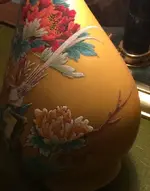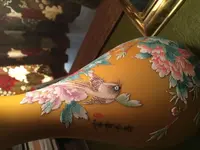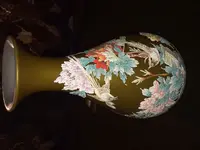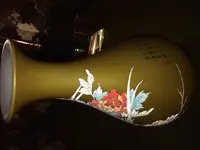You are using an out of date browser. It may not display this or other websites correctly.
You should upgrade or use an alternative browser.
You should upgrade or use an alternative browser.
Vase with strange (glass?) bead surface
- Thread starter cactus367
- Start date
Bruce R
Bronze Member
- Joined
- Mar 18, 2016
- Messages
- 2,272
- Reaction score
- 2,098
- Golden Thread
- 0
- Location
- Shamokin, Pa.
- Detector(s) used
- Whites coinmaster
- Primary Interest:
- Metal Detecting
Don't read Chinese, but it looks expensive.
Upvote
0
austin
Gold Member
- Joined
- Jul 9, 2012
- Messages
- 5,360
- Reaction score
- 3,509
- Golden Thread
- 0
- Location
- San Antonio, Texas
- Detector(s) used
- Garrett 250
- Primary Interest:
- Other
Is there a mark on the bottom?
Upvote
0
DCMatt
Gold Member
- Joined
- Oct 12, 2006
- Messages
- 10,472
- Reaction score
- 13,785
- Golden Thread
- 0
- Location
- Herndon Virginia
- Detector(s) used
- Minelab Equinox 600, EX II, & Musketeer, White's Classic
- Primary Interest:
- Metal Detecting
I believe it says, "The vase in your hand is worth two birds in the bush."
Seriously, I don't know what it says but the image on it looks like some type of heat transferred applique.
I would guess it is a mid to late 20th C decorator item - unless you can show additional markings to research.
DCMatt
Seriously, I don't know what it says but the image on it looks like some type of heat transferred applique.
I would guess it is a mid to late 20th C decorator item - unless you can show additional markings to research.
DCMatt
Upvote
0
Molewacker
Bronze Member
FYI - hope yours is vintage!
Coralene Decoration | Internet Antique Gazette
Coralene Decoration of Ceramics & Glass
Coralene describes a special decorating technique producing a raised or beaded texture used on fine glass and ceramic wares. It was popular during the Victorian era from 1850 to 1900, although it was also used in earlier periods by Japanese artisans and others and has been imitated in later eras.
Coralene decoration was applied primarily to premium wares like satin glass or peach blow because it involved three separate steps in the production process. First the desired design was painted on the piece using a thick enamel paint. Second, tiny glass beads were pressed into the paint, and, third, the piece was again fired to permanently afix the decoration. The glass beads – most often gold, white, opalescent or clear – frequently “melted” in the process forming one rough textured continous design – often a branching motif resembling coral growths, a possible source for the name coralene.
Later wares imitated the original coralene technique by applying dots of paint instead of beads. Some manufactures, including those producing Nippon wares, achieved much the same look with clay slip applied in relief motifs, a process called moriage (although traditional coralene decoration is also found on Nippon).
Reproduction wares with the Corleone “look” have entered the marketplace. The relief decoration, however, has either been painted on the piece or uses beads glued to the surface. In neither case have these pieces received a second firing so the decoration may be easily flaked off.
- See more at: Coralene Decoration | Internet Antique Gazette
Coralene Decoration | Internet Antique Gazette
Coralene Decoration of Ceramics & Glass
Coralene describes a special decorating technique producing a raised or beaded texture used on fine glass and ceramic wares. It was popular during the Victorian era from 1850 to 1900, although it was also used in earlier periods by Japanese artisans and others and has been imitated in later eras.
Coralene decoration was applied primarily to premium wares like satin glass or peach blow because it involved three separate steps in the production process. First the desired design was painted on the piece using a thick enamel paint. Second, tiny glass beads were pressed into the paint, and, third, the piece was again fired to permanently afix the decoration. The glass beads – most often gold, white, opalescent or clear – frequently “melted” in the process forming one rough textured continous design – often a branching motif resembling coral growths, a possible source for the name coralene.
Later wares imitated the original coralene technique by applying dots of paint instead of beads. Some manufactures, including those producing Nippon wares, achieved much the same look with clay slip applied in relief motifs, a process called moriage (although traditional coralene decoration is also found on Nippon).
Reproduction wares with the Corleone “look” have entered the marketplace. The relief decoration, however, has either been painted on the piece or uses beads glued to the surface. In neither case have these pieces received a second firing so the decoration may be easily flaked off.
- See more at: Coralene Decoration | Internet Antique Gazette
Upvote
0
Bruce R
Bronze Member
- Joined
- Mar 18, 2016
- Messages
- 2,272
- Reaction score
- 2,098
- Golden Thread
- 0
- Location
- Shamokin, Pa.
- Detector(s) used
- Whites coinmaster
- Primary Interest:
- Metal Detecting
I told ya it looked expensive!
Upvote
0
redstar
Jr. Member
- Joined
- Mar 31, 2012
- Messages
- 52
- Reaction score
- 13
- Golden Thread
- 0
- Location
- Parkesburg, Pa
- Detector(s) used
- none, yet
- Primary Interest:
- All Treasure Hunting
Yep, its
Coralene Decoration of Ceramics & Glass From what I can see, a nice one. good color saturation. no ware spots. depending on height. I would estimate it starts at $200.00.
Coralene Decoration of Ceramics & Glass From what I can see, a nice one. good color saturation. no ware spots. depending on height. I would estimate it starts at $200.00.
Upvote
0
Similar threads
- Replies
- 0
- Views
- 344
- Question
🔎 UNIDENTIFIED
Today's thrifts. Please help I'd Glass Vase & Snuff Bottle.
- Replies
- 14
- Views
- 893
Users who are viewing this thread
Total: 1 (members: 0, guests: 1)









